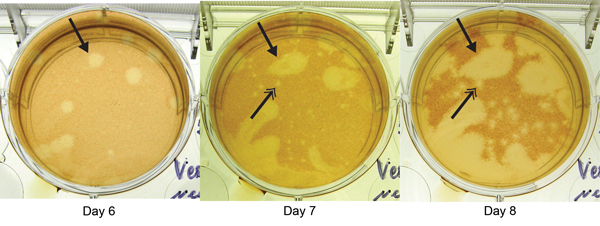Volume 21, Number 5—May 2015
Research
Novel Thogotovirus Associated with Febrile Illness and Death, United States, 2014
Figure 1

Figure 1. Plaque reduction neutralization test of patient sample for Heartland virus, showing images of the same well obtained days 6, 7, and 8 postinoculation at a dilution of 1:20. Arrows with single heads indicate appearance of a novel virus plaque beginning at day 6. Arrows with double heads indicate development of a typical Heartland virus plaque, apparent on day 7 and more evident on day 8, generated from a control strain added to each well in defined quantities to identify Heartland virus–specific antibodies in the patient sample.
Page created: April 19, 2015
Page updated: April 19, 2015
Page reviewed: April 19, 2015
The conclusions, findings, and opinions expressed by authors contributing to this journal do not necessarily reflect the official position of the U.S. Department of Health and Human Services, the Public Health Service, the Centers for Disease Control and Prevention, or the authors' affiliated institutions. Use of trade names is for identification only and does not imply endorsement by any of the groups named above.